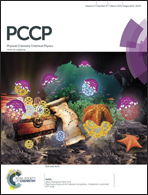Theoretical study on the stability of double-decker type metal phthalocyanines, M(Pc)2 and M(Pc)2+ (M = Ti, Sn and Sc): a critical assessment on the performance of density functionals†
Abstract
We report the results of theoretical calculations on the optimized structures and relative energies between the D4d and D2 symmetry structures for double-decker type phthalocyanine compounds, Ti(Pc)2, Ti(Pc)2+, Sn(Pc)2, Sn(Pc)2+, Sc(Pc)2 and Sc(Pc)2+, using eighteen types of functionals: B3LYP, B3PW91, B3P86, PBE1PBE, BHandHLYP, BPW91, BP86, M06, M06-2x, M06-HF, M06L, LC-BPW91, LC-ωPBE, CAM-B3LYP, B97D, ωB97, ωB97X and ωB97XD. Two phthalocyanine moieties are stacked in a face-to-face configuration in the D4d structure, but they are stapled by two σ-bonds in the D2 one. We found that the molecular symmetry of M(Pc)2 and M(Pc)2+ depends on the balance between stabilization due to electron delocalization and exchange repulsion of π-electrons in the phthalocyanine moieties. We assessed the performance of the well-established functionals to select the appropriate functional for calculations on M(Pc)2 and M(Pc)2+, and several important aspects came out. Generally, the hybrid GGA and hybrid meta-GGA functionals with 20–27% of the HF exchange term would give the molecular structures consistent with the experimental expectations for the double-decker type phthalocyanine compounds. Pure GGA and pure meta-GGA functionals (BPW91, BP86, M06L and B97D) have the tendency to overestimate the stability of the D4d structure. On the other hand, functionals including HF exchange for 50% and over or including long-range corrections (BHandHLYP, M06, M06-2x, M06-HF, LC-BPW91, LC-ωPBE, CAM-B3LYP, ωB97, ωB97X and ωB97XD) tend to overestimate the stability of the D2 structure. It should be emphasized that the B3LYP functional, one of the most commonly used hybrid GGA functionals with 20% HF exchange, cannot estimate the relative stability between the two molecular structures of Ti(Pc)2 appropriately. The calculation for the systems considered in this article required well-balanced treatment of the HF exchange with the accompanied exchange–correlation functional. Thus, as has been pointed out rigorously and frequently, the selection of the functional is a crucial point for reliability of the calculations.


 Please wait while we load your content...
Please wait while we load your content...